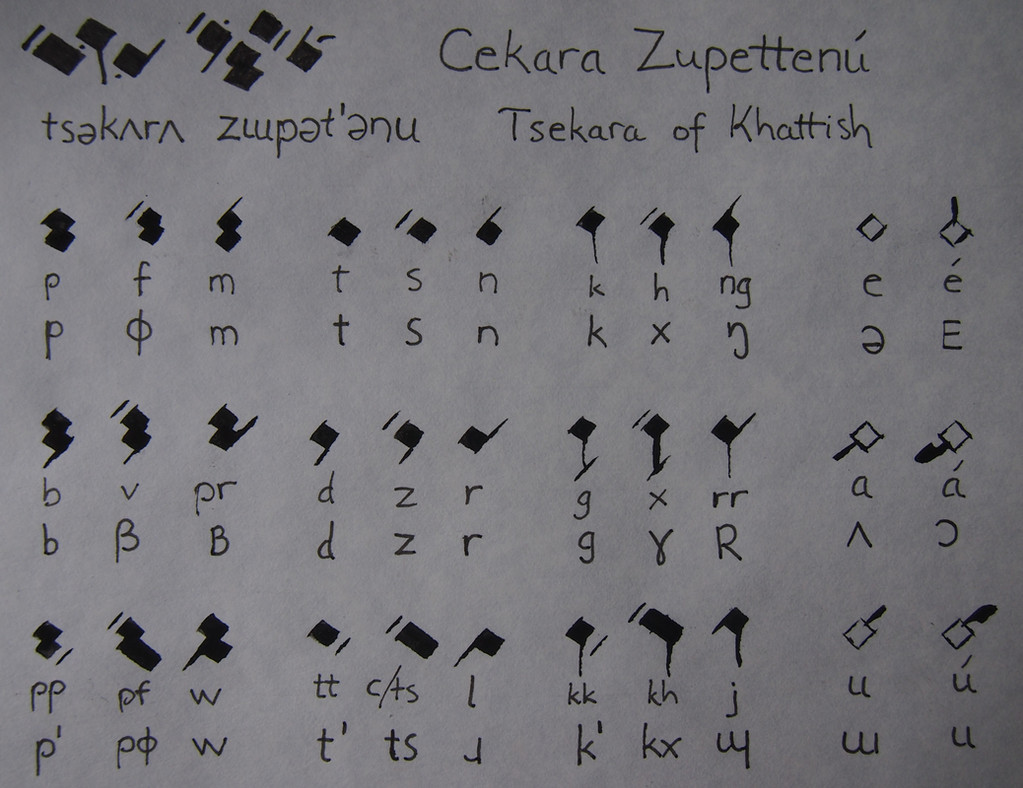HOME | DD
 juhhmi — Tsekara
juhhmi — Tsekara

Published: 2013-08-29 13:08:58 +0000 UTC; Views: 2620; Favourites: 41; Downloads: 12
Redirect to original
Description
Tsekara is the featural abjad writing system for Khattish, native Zupettenú for "Our language".Showing the grapheme, Romanization and IPA pronunciation. On the right we have strong versions of vowel diacritics. The "horn" diacritic will bend away from possible grapheme "spikes" (ascenders or descenders).
See my fantasy world Grundet and its conlangs .
Related content
Comments: 28

It's going to seem like I've copied you, but the language me and my girlfriend are creating is called Litamú, and means "Ours" (ú being a nasal u). But I promise I didn't lol xD
👍: 0 ⏩: 2

No problem! 
What kind of language do you have behind the glyphs? 
The Zupett language of the script is still under construction, but it will have some noun cases, ergative-absolutive alignment, head-initialism, VOS word order and octal numeral base.
👍: 0 ⏩: 2

Right now I'm thinking SVO order (changing to OVS when asking a question) and certain noun cases. As for the other two terms you used, I'm afraid I don't know what they mean lol. Mind explaining them?
👍: 0 ⏩: 1

Morphosyntactic alignment tells how the language makes distinction between verb's "subject" and "object". Compare the two main groups:
* "You saw me." and "I went." former verb being transitive ("see" having an object "me" and "you" being the agent) and latter intransitive (only subject or rather argument "I") with the nominative-accusative alignment of English ("you" and "I" both in nominative).
* In absolutive-ergative the roles/cases have just been chosen differently: In English this would mean "You saw me." and "Me went." where "me" corresponds with the absolutive case while the agent of transitive verb "saw" is in ergative.
With head-initialism I referred to the word order of noun (example of a head) and its modifiers: "plenty of coins" vs. "coins aplenty"
I also recommend you seeing the Language Creation Kit: www.zompist.com/kitgram.html
Have fun with conlanging!
👍: 0 ⏩: 0

Well it's still in its early stages (in fact I need to finish the script - I started out with a abugida but then we decided that it would limit syllable structure too much), but basically since neither of us have made a conlang before, we wanted to test the waters by doing something that would simply fit our preferences and draw from influences familiar to us. For example, the reason that we included nasal vowels was because she has some experience with Polish. The lexicon is going to be partly a priori and partly other languages of our choosing; the word "Litam" comes from both of our last names (Lee-Tamburro), and "aeba," meaning "father," comes from the Hebrew "abba." We don't have much of it but we're excited about it so far
👍: 0 ⏩: 1

Yeah, abugidas and abjads are quite restrictive... That's why I added tones to the language behind my abugida script.
It must be nice to create something together. 
👍: 0 ⏩: 0

Our actual glyphs don't look alike, just the names though, for the record.
👍: 0 ⏩: 0

The use of solid squares really makes it unique! 
👍: 0 ⏩: 1

Thanks - I'm glad you like it! 
👍: 0 ⏩: 0

Great looking abjad, very well done. I am having the worst time distinguishing /ə/ and /ʌ/. And l = /ɹ/? But hey, it's your language. On another note, this reminds me a lot of old square notation for Gregorian Chant.
👍: 0 ⏩: 1

Thank you!
Oh, yeah... I was doing some last minute changes to the vowels so those became quite close to each other. I also wanted to play with the orthography... Even I am not fully satisfied with it, but I decided to go with this. It would create interesting situations when someone not knowing the actual sounds would try to understand the natives.
Yes, it seems to remind.
👍: 0 ⏩: 1

You should make a minimal pair where only a change between /ə/ and /ʌ/ would be the difference between saying something nice and saying something incredibly rude. Just for funsies.
👍: 0 ⏩: 1

lol I did consider noun to adjective change...
👍: 0 ⏩: 1

As would I! lol
I had slight problems with my calligraphy pen and ink so I drew the heading with a drawing pen. I will have to see what I can come up with...
👍: 0 ⏩: 0

Yes, indeed! I was supposed to write that in the description, but wrote "phonetic" instead (though it is quite phonetic as well). Thanks!
👍: 0 ⏩: 0

Do I understand it right that the line you drew on the vowels just indicate the placement of a dot that will be read as the vowel? At least in the top left where you wrote the name of the language it looks much like its just marked with a dot.
This script looks very interesting, and I love how you combined the tool nib used for the writing with the shape of the letters and the use of the four corners to store the vowels in. Very well planned and very inspirational
👍: 0 ⏩: 2

There are a couple of ways of writing the vowel diacritics:
* most often they aren't written (consonantal roots)
* "weak marks" as in the top heading to avoid confusion
* "strong marks" shown on the right which become strong because they are written with the same nib... (perhaps for beginners and monumental texts)
Thank you very much! 
👍: 0 ⏩: 1

Oooh i see now. Thanks for the info X3 You really did put much thought into the logic of this script, i love that!
👍: 0 ⏩: 1

No problem! 
👍: 0 ⏩: 1

Nope, i dont think it reduces the plausibility :3 I even rememebered what this script reminds me of: Medieval music sheets 
👍: 0 ⏩: 1

Great! 
👍: 0 ⏩: 0

Certain regular alphabets and abjads use a diminished diacritic to demonstrate a common or ambiguous vowel; in particular, Hangul (Korean) used to use a dot as an alternative to the /a/ vowel. Given the description in the comment of "strong" vowel diacritics, I'm guessing · stands in for any unstressed or unambiguous vowel.
👍: 0 ⏩: 2

I see! thank you for the clarifications
👍: 0 ⏩: 0

Quite well figured out! I replied a longer answer to the original comment... But the stress could be indicated with strong diacritics for example to change verb mood.
👍: 0 ⏩: 0




























